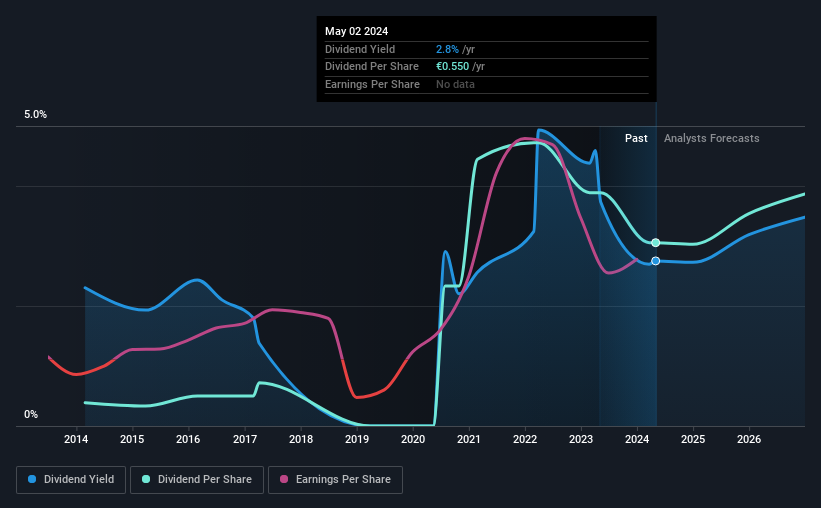
Fluidra, S.A. (BME:FDR) is reducing its dividend from last year's comparable payment to €0.243 on the 3rd of July. This means that the annual payment will be 2.8% of the current stock price, which is in line with the average for the industry.
See our latest analysis for Fluidra
Fluidra's Earnings Easily Cover The Distributions
Unless the payments are sustainable, the dividend yield doesn't mean too much. Prior to this announcement, Fluidra's dividend made up quite a large proportion of earnings but only 29% of free cash flows. Since the dividend is just paying out cash to shareholders, we care more about the cash payout ratio from which we can see plenty is being left over for reinvestment in the business.
The next year is set to see EPS grow by 107.3%. If the dividend continues along recent trends, we estimate the payout ratio will be 51%, which would make us comfortable with the sustainability of the dividend, despite the levels currently being quite high.

Dividend Volatility
The company's dividend history has been marked by instability, with at least one cut in the last 10 years. Since 2014, the annual payment back then was €0.07, compared to the most recent full-year payment of €0.55. This implies that the company grew its distributions at a yearly rate of about 23% over that duration. It is great to see strong growth in the dividend payments, but cuts are concerning as it may indicate the payout policy is too ambitious.
Dividend Growth Could Be Constrained
With a relatively unstable dividend, it's even more important to see if earnings per share is growing. Fluidra has seen EPS rising for the last five years, at 36% per annum. Earnings per share is growing nicely, but the company is paying out most of its earnings as dividends. This might be sustainable, but we wonder why Fluidra is not retaining those earnings to reinvest in growth.
In Summary
In summary, dividends being cut isn't ideal, however it can bring the payment into a more sustainable range. The payments haven't been particularly stable and we don't see huge growth potential, but with the dividend well covered by cash flows it could prove to be reliable over the short term. We would probably look elsewhere for an income investment.
Companies possessing a stable dividend policy will likely enjoy greater investor interest than those suffering from a more inconsistent approach. At the same time, there are other factors our readers should be conscious of before pouring capital into a stock. For instance, we've picked out 2 warning signs for Fluidra that investors should take into consideration. Looking for more high-yielding dividend ideas? Try our collection of strong dividend payers.
New: AI Stock Screener & Alerts
Our new AI Stock Screener scans the market every day to uncover opportunities.
• Dividend Powerhouses (3%+ Yield)
• Undervalued Small Caps with Insider Buying
• High growth Tech and AI Companies
Or build your own from over 50 metrics.
Have feedback on this article? Concerned about the content? Get in touch with us directly. Alternatively, email editorial-team (at) simplywallst.com.
This article by Simply Wall St is general in nature. We provide commentary based on historical data and analyst forecasts only using an unbiased methodology and our articles are not intended to be financial advice. It does not constitute a recommendation to buy or sell any stock, and does not take account of your objectives, or your financial situation. We aim to bring you long-term focused analysis driven by fundamental data. Note that our analysis may not factor in the latest price-sensitive company announcements or qualitative material. Simply Wall St has no position in any stocks mentioned.
About BME:FDR
Fluidra
Designs, manufactures, distributes, and markets accessories and machinery for swimming-pools, irrigation and water treatment, and residential and commercial pool purification market worldwide.
Solid track record average dividend payer.
Similar Companies
Market Insights
Community Narratives



